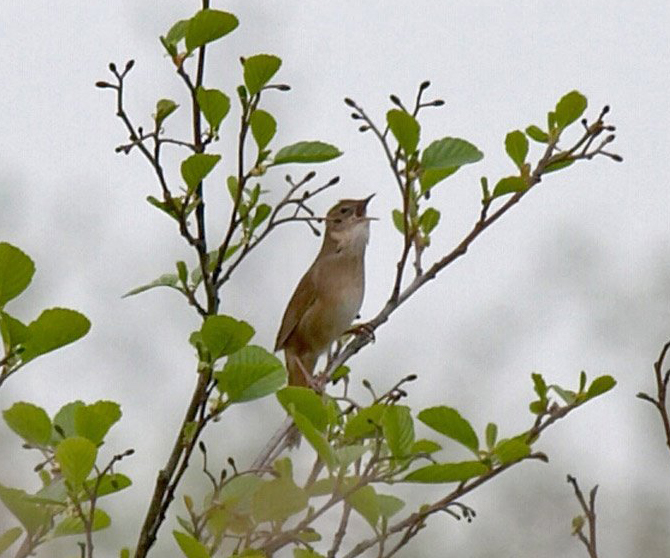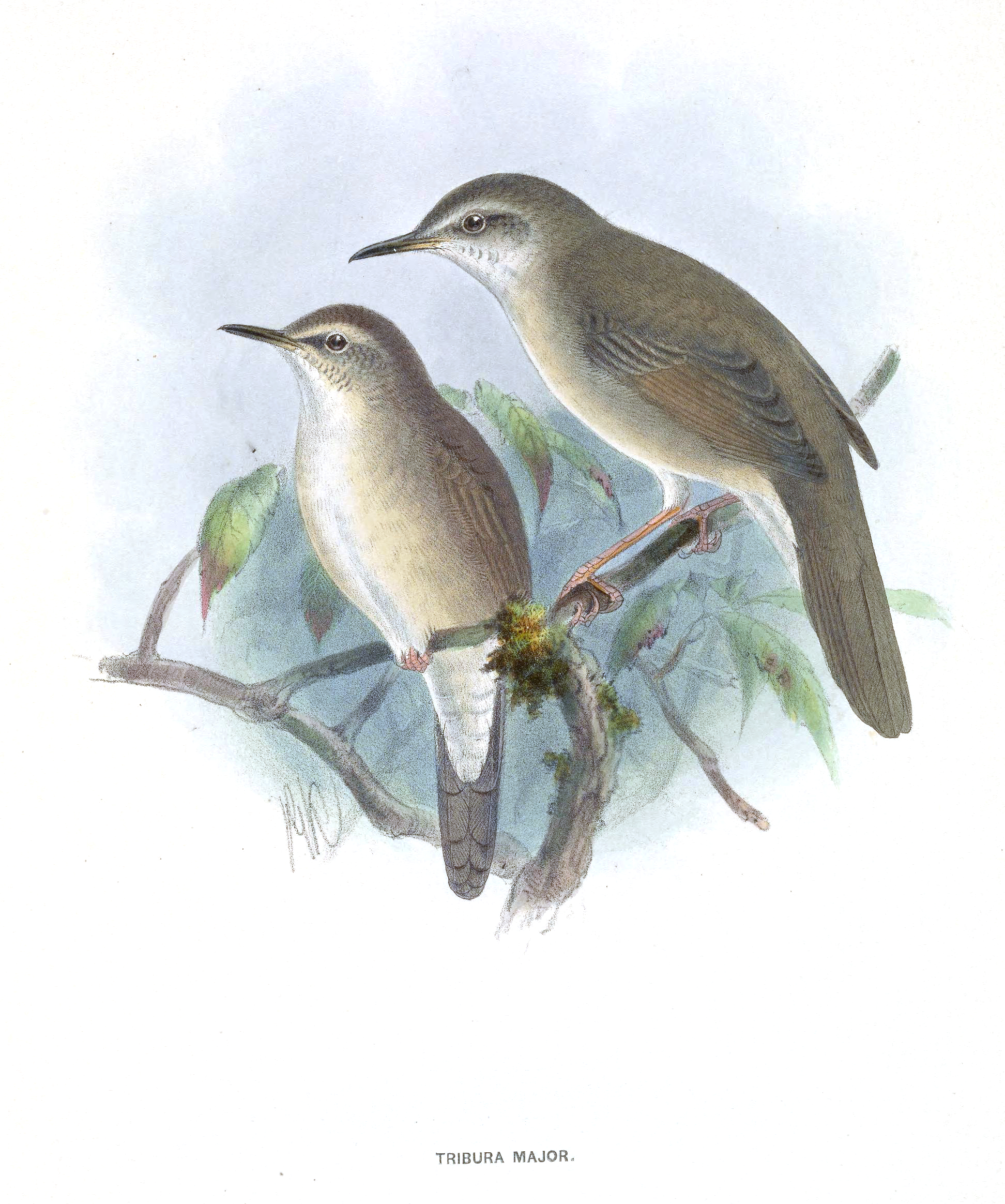|
Locustella
''Locustella'' is a genus of small passerine birds that include the grasshopper warblers. Formerly placed in the paraphyletic "Old World warbler" assemblage, they are now considered the northernmost representatives of a largely Gondwanan family, the Locustellidae. These are rather drab brownish "warblers" usually associated with fairly open grassland, shrubs or marshes. Some are streaked, others plain, all are difficult to view. They are insectivorous. The most characteristic feature of this group is that the song of several species is a mechanical insect-like reeling which gives rise to the group's scientific name. Species breeding in temperate regions are strongly bird migration, migratory. Taxonomy The genus ''Locustella'' was introduced by the German naturalist Johann Jakob Kaup in 1829 with the common grasshopper warbler (''Locustella naevia'') as the type species. The genus name ''Locustella'' is from Latin and is a diminutive of ''locusta'', "grasshopper". Like the En ... [...More Info...] [...Related Items...] OR: [Wikipedia] [Google] [Baidu] |
Savi's Warbler
Savi's warbler (''Locustella luscinioides'') is a species of Old World warbler in the genus ''Locustella''. It breeds in Europe and the western Palearctic. It is bird migration, migratory, wintering in northern and sub-Saharan Africa. This small passerine bird is found in reed beds, usually with some bushes. Three to six eggs are laid in a nest in reeds. The adult has an unstreaked grey-brown back, whitish grey underparts and a lack of throat streaks, which is a distinction from the river warbler. The sexes are identical, as with most warblers, but young birds are yellower below. Like most warblers, it is insectivorous. This is not a shy species, but can be difficult to see in the reeds except sometimes when singing. The is a monotonous mechanical insect-like reeling, often given at dusk. It is similar to the song of other species in the group, but is generally faster and deeper and bears a strong resemblance to that of Roesel's bush-cricket. Taxonomy The common name of this bi ... [...More Info...] [...Related Items...] OR: [Wikipedia] [Google] [Baidu] |
Common Grasshopper Warbler
The common grasshopper warbler or just grasshopper warbler (''Locustella naevia'') is a species of Old World warbler in the genus ''Locustella''. It breeds across much of temperate Europe and the western Palearctic. It is bird migration, migratory, wintering across northern tropical Africa just south of the Sahara, and also locally in India. This small passerine bird is found in dense grassland vegetation, often close to water, and usually with a few small scattered shrubs. It is a medium-sized warbler about long. The adult has a streaked brown back and whitish grey underparts which are unstreaked except on the undertail coverts. The sexes are identical, as with most warblers, but young birds are yellower below. Like most warblers, it is insectivorous. Four to seven Egg (biology), eggs are laid in a nest on or near the ground in thick vegetation or in a bunch grass, tussock of grass. This is a species which skulks in the undergrowth, creeping through bushes and low foliage, and ... [...More Info...] [...Related Items...] OR: [Wikipedia] [Google] [Baidu] |
River Warbler
The river warbler (''Locustella fluviatilis'') is an Old World warbler in the genus ''Locustella''. It breeds in eastern and central Europe, and into the western Palearctic. It is bird migration, migratory, wintering in inland southern Africa, from around the Zambezi River south to the vicinity of Pretoria in South Africa. Taxonomy and etymology The genus name ''Locustella'' is from Latin and is a diminutive of ''locusta'', "grasshopper". This refers to the song of the common grasshopper warbler and some others in this genus. The specific ''fluviatilis'' is Latin for "of a river". It's a monotypic species. Description This is a largish warbler. The adult has an unstreaked grey-brown back, whitish grey underparts, and a darker undertail, which has white feather tips giving a contrasting pattern. The sexes are identical, as with most warblers, but young birds are yellower below. Some birds can show reduced dark markings on the covert feather, undertail coverts (caused by mo ... [...More Info...] [...Related Items...] OR: [Wikipedia] [Google] [Baidu] |
Lanceolated Warbler
The lanceolated warbler (''Locustella lanceolata'') is a species of Old World warbler in the genus ''Locustella''. It breeds from northeast European Russia across the Palearctic to northern Hokkaidō, Japan. It is migratory, wintering in Southeast Asia. The genus name ''Locustella'' is from Latin and is a diminutive of ''locusta'', "grasshopper". This refers to the song of the common grasshopper warbler and some others in this genus. The specific '' lanceolata'' is Latin for "spear-shaped" and refers to the streaks on the breast. This small passerine bird is a species found in grassland with some thicker shrubby vegetation or trees, often close to water in bogs or wet clearings. Five eggs are laid in a nest in a tussock. This species is a rare vagrant to western Europe. One of the best places to see this skulking species as a vagrant is Fair Isle, Shetland. This is a small warbler. The adult has a streaked brown back and whitish grey underparts, which have small lance-head l ... [...More Info...] [...Related Items...] OR: [Wikipedia] [Google] [Baidu] |
Taiwan Bush Warbler
The Taiwan bush warbler (''Locustella alishanensis'') is a species of Old World warbler in the family Locustellidae. It is found only in Taiwan. Its natural habitat is undergrowth and grassland in elevation. It was first recorded in 1917 and named as a distinct species in 2000. The International Union for Conservation of Nature (IUCN) has assessed it as a least-concern species. Taxonomy This bush warbler was first recorded from Alishan in 1917. At first, it was thought to be a population of ''Bradypterus luteoventris''. In 1952, Jean Théodore Delacour placed it within subspecies ''idoneus'' of ''B. seebohmi'' (now split into several species). Later authorities placed it in subspecies ''melanorhynchus''. In the late 1980s, its song was found to be very distinctive, unlike other related species. In 2000, Pamela C. Rasmussen, Philip D. Round, Edward C. Dickinson and Frank Rozendaal described the population as a distinct species, ''Bradypterus alishanensis'', based on its dis ... [...More Info...] [...Related Items...] OR: [Wikipedia] [Google] [Baidu] |
Benguet Bush Warbler
The Benguet bush warbler (''Locustella seebohmi''), also known as the Benguet grasshopper-warbler, is a songbird species. Formerly placed in the "Old World warbler" assemblage, it is now placed in the newly recognized family Locustellidae. It is found in the mountains of northern Luzon in the Philippines. Description EBird describes the bird as "A fairly small, slender bird of lower montane grassy valleys. Warm brown above and on the belly, with a white throat and a faintly streaked grayish chest. Note indistinct pale brow and pale barring across the base of the undertail. Very skulking. Similar to Long-tailed Bush-Warbler, but has shorter tail and grayish rather than deep brown underparts. Also similar to Philippine Bush-Warbler but with less distinct pale eyebrow. Song is a sequence of piercing and grating ringing notes repeated at regular intervals." Previously placed in '' Bradypterus'' but is now in ''Locustella''. It was formerly conspecific with the Russet bush warble ... [...More Info...] [...Related Items...] OR: [Wikipedia] [Google] [Baidu] |
Long-billed Bush Warbler
The long-billed bush warbler (''Locustella major'') is a rare species of Old World warbler in the family Locustellidae. It is found in China, India, Pakistan, and Tajikistan. It is also known as long-billed grasshopper warbler. Taxonomy The Long-billed bush warbler was described by Irish ornithologist William Edwin Brooks in 1871 with the given type locality of "Kashmir". He gave it the name ''Dumeticola major'', with ''Dumeticola'' meaning inhabiting thickets, owing to the habitat of the bird and ''major'' being a reference to it being larger than the Baikal bush warbler (then under the name ''Dumeticola affinis''). It was later placed in the genus ''Locustella'', which is a reference to the locust-like call of the birds in the genus. There a currently two recognized subspecies: * ''L. m. major'' - (Brooks, 1871): Found in the Himalayas from Tajikistan through Pakistan into Kashmir * ''L. m. innae'' - (Leonid Portenko, 1955): The Kunlun Mountains in Xinjiang, China Description ... [...More Info...] [...Related Items...] OR: [Wikipedia] [Google] [Baidu] |
Dalat Bush Warbler
The Dalat bush warbler (''Locustella idonea'') is a songbird species. Formerly placed in the "Old World warbler" assemblage, it is now placed in the newly recognized family Locustellidae. It was until recently considered a subspecies of ''Locustella mandelli'' and the name "russet bush warbler" was applied to the entire species complex. After this was split up, "Dalat bush warbler" was proposed. Some authorities still consider this species conspecific with the russet bush warbler. The species is found in south-central Vietnam Vietnam, officially the Socialist Republic of Vietnam (SRV), is a country at the eastern edge of mainland Southeast Asia, with an area of about and a population of over 100 million, making it the world's List of countries and depende .... References Locustella Birds of Vietnam Birds described in 1940 {{Locustellidae-stub ... [...More Info...] [...Related Items...] OR: [Wikipedia] [Google] [Baidu] |
Long-tailed Bush Warbler
The long-tailed bush warbler (''Locustella caudata'') also known as the Long-tailed grasshopper-warbler is a species of grass warbler (family Locustellidae). It was formerly included in the "Old World warbler" assemblage. It is found only in the Philippines on the islands of Mindanao and Luzon. Description and taxonomy EBird describes the bird as "A fairly small, long-tailed bird of montane forest undergrowth. Dark brown above with an orange-brown belly, a gray chest, a white throat and eyebrow, mainly in front of the eye, and a long graduated tail which it often holds cocked. Very skulking. Similar to Benguet and Philippine Bush-Warblers, but has a longer tail and deeper brown belly. Song is a sharp “tik!” followed by a ringing high-pitched buzz." Three subspecies are recognised: * ''L. c. caudata''– all of Mindanao except the Zamboanga Peninsula; Longer tail * ''L. c. malindangensis'' – west Mindanao in the Zamboanga Peninsula - Darker sides on face and a whiter thr ... [...More Info...] [...Related Items...] OR: [Wikipedia] [Google] [Baidu] |
Chinese Bush Warbler
The Chinese bush warbler (''Locustella tacsanowskia'') is an Old World warbler in the family Locustellidae. The species was first described by Robert Swinhoe in 1871. It breeds in the East Palearctic (East Siberia to Tibet and South China); it winters to Northeast India, Yunnan and Southeast Asia. Its natural habitat is temperate forest A forest is an ecosystem characterized by a dense ecological community, community of trees. Hundreds of definitions of forest are used throughout the world, incorporating factors such as tree density, tree height, land use, legal standing, ...s. References Chinese bush warbler Birds of China Birds of East Asia Chinese bush warbler Taxonomy articles created by Polbot Taxa named by Robert Swinhoe {{Locustellidae-stub ... [...More Info...] [...Related Items...] OR: [Wikipedia] [Google] [Baidu] |
West Himalayan Bush Warbler
The West Himalayan bush warbler (''Locustella kashmirensis'') is a species of Old World warbler in the family Locustellidae. It is found in the northwestern Himalayas. It was previously considered conspecific with the spotted bush warbler. Its natural habitat is temperate forest A forest is an ecosystem characterized by a dense ecological community, community of trees. Hundreds of definitions of forest are used throughout the world, incorporating factors such as tree density, tree height, land use, legal standing, ...s. References West Himalayan bush warbler Birds of North India West Himalayan bush warbler {{Locustellidae-stub ... [...More Info...] [...Related Items...] OR: [Wikipedia] [Google] [Baidu] |




